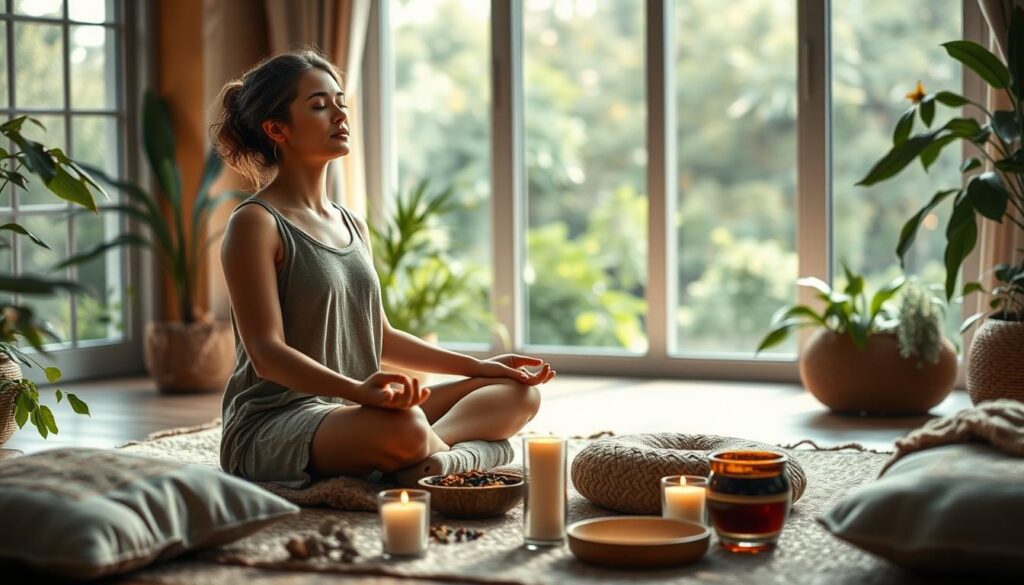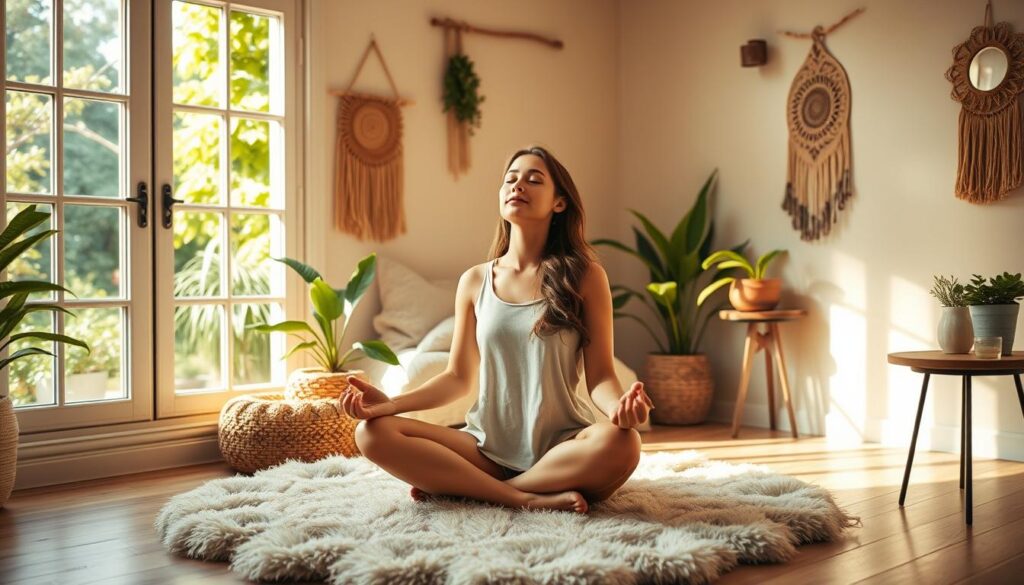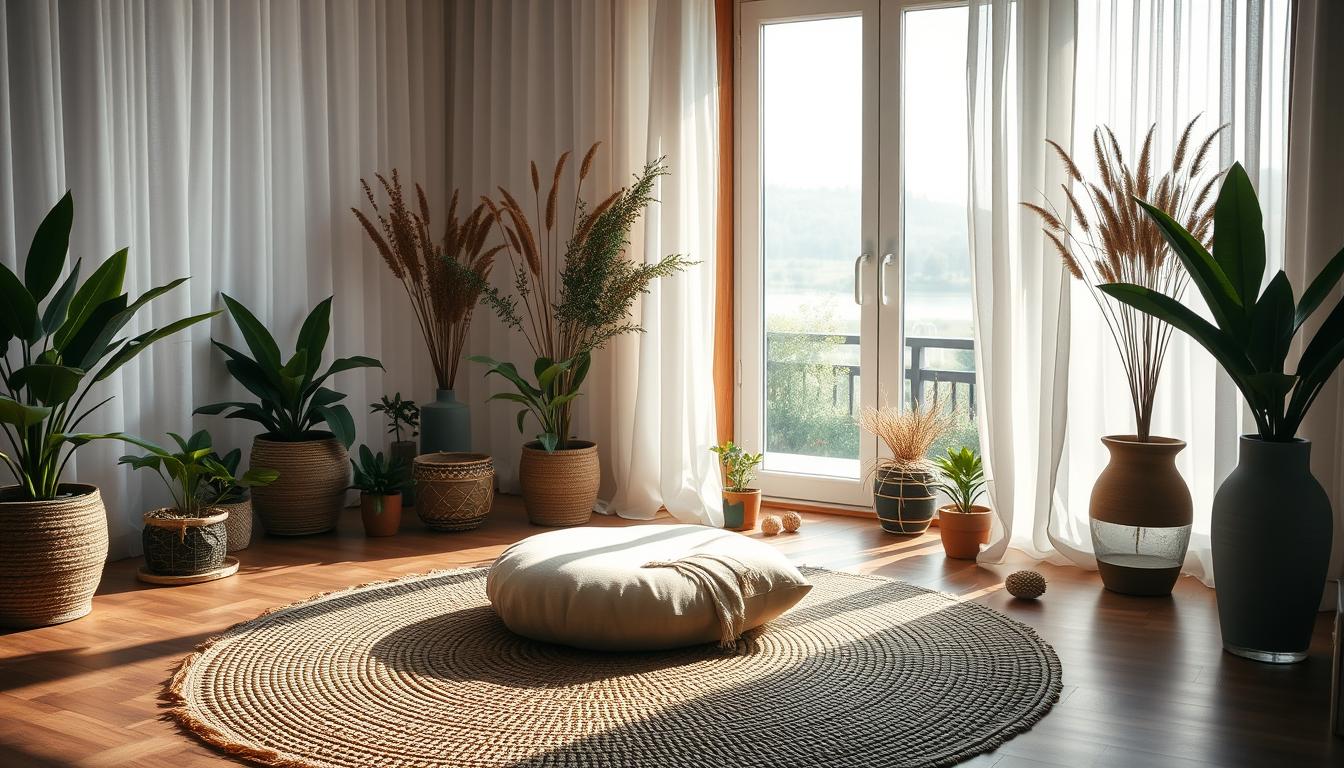I still remember the mornings when I’d rush out of bed, already feeling overwhelmed by the day ahead. It wasn’t until I discovered the power of a meditation practice that my mornings – and my life – began to transform.
Starting your day with just a few moments of mindfulness can be incredibly empowering. A short, daily practice can bring clarity and purpose, setting a positive tone for the day ahead.
The beauty of this meditation lies in its simplicity and accessibility. You don’t need to be a seasoned practitioner or have a specific spiritual background to benefit from it. It’s about taking a few moments each morning to focus on your breath and calm your mind.
By incorporating this simple yet powerful practice into your daily routine, you’ll begin to experience its numerous benefits, from improved mental clarity to enhanced physical wellness.
Key Takeaways
- Starting your day with a short meditation practice can boost clarity and purpose.
- Meditation is accessible to everyone, regardless of experience or background.
- Consistency is more important than the duration of your practice.
- Focusing on your breath is a simple yet effective way to calm your mind.
- Regular practice can lead to improved mental and physical well-being.
- A boho-inspired approach combines comfort and personal expression with mindfulness.
The Power of Morning Meditation
The way we begin our day sets the tone for everything that follows. For many of us, the morning is a chaotic rush to get out the door on time, but it doesn’t have to be that way. Incorporating a morning meditation practice can transform your day, setting a calm and focused tone from the very start.
Why the First Moments of Your Day Matter
The first moments of your day are crucial because they establish your mental and emotional state. By dedicating a few minutes to meditation in the morning, you’re not just starting your day calmly; you’re also building a foundation for mindfulness that can last throughout the day. Studies have shown that regular morning meditation practice can lead to improved emotional regulation and reduced stress levels.
Here are some key benefits of morning meditation:
- Strengthens neural connections, much like a “push-up for the brain”
- Alters dopamine levels, influencing mood and motivation
- Enhances the prefrontal cortex, supporting executive function and decision-making
- Activates the parasympathetic nervous system, reducing stress hormones through breath-focused meditation
The Science Behind Morning Mindfulness
Research into the effects of meditation has shown that even brief periods of mindfulness can improve attention and focus. By creating new neural pathways, morning meditation supports mindfulness throughout the day. Consistent practice over time leads to structural changes in the brain, enhancing emotional regulation.
| Benefits | Description | Impact |
|---|---|---|
| Neural Connection Strength | Meditation strengthens neural connections | Improved cognitive function |
| Dopamine Levels | Regular practice alters dopamine levels | Better mood regulation |
| Prefrontal Cortex | Meditation enhances the prefrontal cortex | Enhanced decision-making |
By dedicating just a few minutes each morning to meditation, you’re not just feeling good in the moment – you’re physically changing how your brain functions. This practice can be a powerful way to take control of your day, improving your focus and mental clarity from the very start.
Benefits of a 5 Minute Meditation Morning Practice
A brief morning meditation practice can be the key to unlocking a more mindful and productive day. By dedicating just a few minutes each morning to meditation, you can experience a range of benefits that can positively impact your day.
Mental Clarity and Improved Focus
One of the primary benefits of a morning meditation practice is improved mental clarity and focus. Regular meditation helps train your mind to stay present and aware, allowing you to tackle tasks with greater efficiency. As you begin your day with a clear mind, you’ll be better equipped to prioritize tasks and make decisions. According to a study on the benefits of a 5-minute meditation, even short periods of meditation can have a significant impact on cognitive function.
Stress Reduction and Emotional Resilience
Morning meditation is also an effective way to reduce stress and build emotional resilience. By starting your day with a calm and centered mindset, you’ll be better able to handle life’s challenges as they arise. Meditation has been shown to decrease the production of stress hormones like cortisol, leading to a more balanced and peaceful state of being. As you cultivate emotional resilience through regular meditation, you’ll find it easier to navigate life’s ups and downs with greater ease and composure, ultimately enhancing your overall mood and quality of life.
Physical Benefits for Your Body and Brain
The benefits of meditation extend beyond mental and emotional wellbeing to positively impact your physical health. Regular meditation has been linked to reduced inflammation, improved immune function, and lower blood pressure. It can also help regulate your sleep patterns, leading to better rest and recovery. As you incorporate meditation into your daily practice, you may notice improvements in digestion and a reduction in tension-related pain.
| Physical Benefits | Mental Benefits |
|---|---|
| Reduced inflammation | Improved mental clarity |
| Lower blood pressure | Enhanced emotional resilience |
| Improved sleep quality | Better focus and concentration |

“Meditation is not a way of making your mind quiet. It’s a way of entering into the quiet that’s already there – buried under the 50,000 thoughts the average person thinks every day.”
As you continue your meditation journey, you’ll likely find that the physical and mental benefits are interconnected, creating a positive cycle of wellbeing that enhances your overall quality of life.
Creating Your Boho Meditation Space
Your meditation space is a sanctuary, and creating a boho-inspired space can be a powerful way to enhance your meditation practice. As you begin to create this space, consider how different elements can come together to create a calming and grounding atmosphere.
Essential Elements for a Calming Environment
To create a calming environment, incorporate natural elements like plants, wood, and stones. These elements can help create a grounding atmosphere, making it easier to stay present during your meditation practice.
Textiles with varied textures, such as cushions, rugs, and blankets, can add comfort and visual interest to your space. For example, a plush rug can make your space feel cozier, while a few well-placed cushions can provide support during your practice. You can also use incense, essential oils, or candles to create a ritual through scent, marking your meditation time.
Personalizing Your Space with Boho Elements
Personalize your space with elements that resonate with you, such as handcrafted or vintage items, which can add character and personal connection to your space. For instance, a handmade cushion or a vintage piece of art can serve as a focal point that inspires your practice. You can also use color choices to affect your mood—earthy tones for grounding, blues for calm, etc. For more ideas on creating a healing space at home, you can visit this resource.
Creating a space that feels authentic to you can encourage a routine of self-compassion, making it easier to maintain a consistent practice, even if it’s just a one-minute practice. As you make your space, remember that it should feel good to your body and inspire you to return to your practice regularly, making it a part of your daily routine.
Your 5 Minute Morning Meditation Guide
A 5-minute morning meditation practice is a simple yet powerful way to cultivate mindfulness and set intentions for the day.
Finding the Perfect Time in Your Morning Routine
Finding the perfect time to meditate in the morning can be as simple as waking up 5 minutes earlier. It is essential to experiment and identify a consistent time that works best for you, making it a seamless part of your daily routine. For instance, you can try meditating right after waking up, or you can do it after a short exercise routine or after having a glass of water – it is entirely up to you and what you find most convenient.
Proper Posture and Body Positioning
Maintaining proper posture is crucial during meditation. You can choose to sit on a chair or on a cushion on the floor, whichever feels more comfortable to you. Keep your back straight, and your hands placed gently on your lap or on your knees. You can close your eyes or keep them lightly closed, focusing on your breath. 
Breathing Techniques for Beginners
For beginners, focusing on the breath is a simple yet effective technique. Take slow, deep breaths in through your nose and out through your mouth. As you breathe in, your abdomen should expand; as you breathe out, it should contract. If your mind starts to wander, gently bring your focus back to your breath without any self-criticism.
Dealing with Wandering Thoughts
It is normal for the mind to wander, especially in the early days of meditation practice. When you notice your mind wandering, gently bring your attention back to your breath. Labeling your thoughts as “thinking” can help you create distance from the content of your thoughts. Using guided meditation can also provide a structured framework that helps minimize mind-wandering.
Here is a simple table to help you track your meditation practice and understand its impact:
| Day | Meditation Time | Observations |
|---|---|---|
| 1 | 5 minutes | Feeling more relaxed |
| 2 | 5 minutes | Noticed less mind-wandering |
| 3 | 5 minutes | Improved focus throughout the day |
3 Simple Boho Morning Meditation Practices
Boho morning meditation practices offer a unique way to begin your day with mindfulness. By incorporating these practices into your morning routine, you can cultivate a sense of calm and clarity that sets a positive tone for the day ahead.
Basic Breath Awareness Meditation
Basic breath awareness meditation is a fundamental practice that involves focusing on your breath to calm the mind. To practice, find a comfortable seated position, close your eyes, and bring your attention to your breath. Notice the sensation of the air entering and leaving your nostrils. When your mind wanders, gently bring it back to your breath without judgment. This practice helps to cultivate mindfulness and can be done in just aminuteor two. Regular practice can lead to improved mental clarity and reduced stress.
Body Scan Meditation for Morning Energy
Body scan meditation is another effective way to start your day with energy and awareness. Lie down or sit comfortably, and bring your attention to different parts of your body, starting from your toes and moving up to the top of your head. Notice any areas of tension or discomfort without judgment. This practice helps to release physical tension and can be particularly beneficial in the morning to get your energy flowing. As you focus on each body part, take a deep breath in and out, imagining any tension melting away.
| Body Part | Sensation | Action |
|---|---|---|
| Toes | Tension | Release |
| Abdomen | Relaxation | Breathe deeply |
| Head | Lightness | Smile |
Loving-Kindness Morning Practice
Loving-kindness meditation is a powerfulpracticethat cultivates compassion for yourself and others. To practice, start by directing kind thoughts towards yourself, using simple phrases such as “May I be happy, may I be healthy, may I be at peace.” Gradually extend these wishes to others, including friends, family, and even those you may have difficulty with. Thismeditation practicesets a positive emotional tone for thedayahead and can be supported byguided meditationrecordings. Even aone-minuteversion of this practice can shift your perspective in meaningful ways.
As the renowned meditation teacher, Sharon Salzberg, once said, “Loving-kindness is a practice that can profoundly change our lives, cultivating a sense of connection and compassion.”
“The more you praise and celebrate your life, the more there is in life to celebrate.” –
By incorporating these simple boho morning meditation practices into your daily routine, you can create a more mindful and compassionate approach to your day.
Integrating Meditation into Your Busiest Mornings
You don’t need extra time to meditate; you just need to integrate it into your existing morning routine. As someone who’s been there, I can attest that even the busiest mornings can accommodate mindfulness practices.
Meditation for the Time-Pressed
For those mornings when time is scarce, it’s essential to have quick yet effective meditation practices. One approach is to focus on breath awareness while you’re getting ready. Take a few deep breaths as you brush your teeth, or pause for a moment to notice the sensation of the water while you’re washing your face. As the renowned mindfulness expert, Jon Kabat-Zinn, once said, “The best way to take care of the future is to take care of the present moment.”
“The best way to take care of the future is to take care of the present moment.” – Jon Kabat-Zinn
Another strategy is to use mindful movement to your advantage. Gentle stretching or yoga poses can be combined with breath awareness, setting a positive tone for the day. Even a short walk to work can become a meditation practice if you pay attention to your surroundings and the sensation of your feet touching the ground.
Combining Meditation with Other Morning Activities
Transforming daily activities into meditation practices can be incredibly effective. For instance, turning your morning coffee or tea into a sensory experience can be a great way to practice mindfulness. Notice the aroma, the taste, and the warmth of the cup in your hands. As you savor your beverage, you’re cultivating a moment of mindfulness that can positively impact your day.
Other activities like showering or commuting can also become opportunities for meditation. Paying attention to the sensations, sights, and sounds around you can help you stay present. By doing so, you’re not just saving time; you’re also enhancing your mindfulness throughout the day. Regular meditation practice can gradually change brain patterns, making mindfulness more natural over time. As a result, you’ll find it easier to stay mindful even on the busiest of days.
By incorporating these practices into your daily routine, you’ll be able to maintain consistency across days, even when your energy or motivation levels fluctuate. The key is to be flexible and creative with your meditation practice, ensuring that it becomes an integral part of your morning, regardless of how busy you are.
Conclusion: Embracing the 5-Minute Morning Meditation Journey
Embracing a five-minute morning meditation practice is a simple yet powerful way to enhance your daily life. By dedicating just a few minutes each day to mindfulness, you can experience a significant shift in your overall well-being.
The benefits of establishing a consistent meditation practice are numerous, from improved focus and reduced stress to enhanced mood and better sleep quality. It’s not about adding another task to your morning routine but creating a moment of peace that sets a positive tone for the day.
Starting with just five minutes a day and being patient with yourself as you develop this habit is key. Remember, meditation is a practice of self-compassion, not another way to judge yourself. Guided meditations can support your practice when needed, and as you progress, you might find your practice expanding naturally.
By incorporating mindfulness meditation into your morning routine, you’re not just improving your mornings; you’re cultivating a more mindful approach to life. So, take this small step towards a more mindful you – your mind, body, and brain will thank you.
FAQ
What are the benefits of practicing mindfulness meditation?
Practicing mindfulness meditation can lead to improved focus, reduced stress levels, and enhanced emotional resilience – all of which can contribute to a better overall quality of life.
How can I make meditation a part of my daily routine?
Start by setting aside a consistent time each day – ideally at the start of your day – and dedicate it to meditation, even if it’s just a short practice.
What is the ideal environment for meditation?
Create a calming environment by incorporating elements like plants, soft lighting, and comfortable seating, making it a space where you feel relaxed and at ease.
How can I deal with a wandering mind during meditation?
Gently acknowledge the thought and bring your focus back to your breath or chosen meditation practice, being kind to yourself as you cultivate this awareness.
Can meditation really help improve my mood and reduce stress?
Yes, regular meditation practice has been shown to improve mood and reduce stress levels by promoting relaxation and enhancing emotional resilience.
How can I maintain a consistent meditation practice?
Make it a habit by incorporating it into your daily routine, being patient with yourself, and using guided meditations as a helpful tool to keep you on track.
